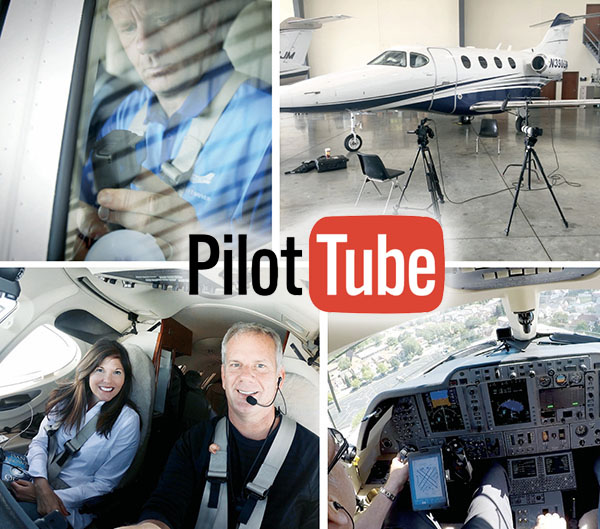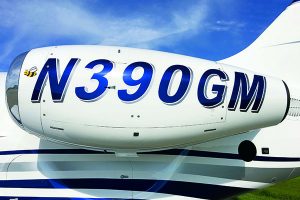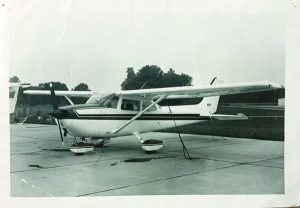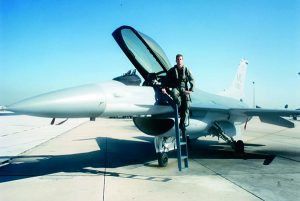
Twin & Turbine Magazine
PILOTTUBE: OWNER-PILOTS INVITE VIEWERS INTO THE COCKPIT.
Premier 1 Driver: Have jet. Will travel.
What do you get when you combine an experienced F-16 pilot, a Beechcraft Premier 1A jet, and a cockpit full of cameras with some creative videography and YouTube? You get Premier 1 Driver and the chance to fly “right seat” as Greg Mink travels to exciting locations throughout the United States, Canada and the Caribbean.
Mink’s Background
Like most American families, when Greg Mink was growing up in Indiana, dinner time was “family time.” And, like most of us, evening conversations started with, “What’s new?” or, “What did you do today?” Usually, those questions were answered by “Not much” or, “Nothing very interesting.” But Mink vividly remembers one dinner time conversation in 1982 when his dad had a new and, what turned out to be, life-altering answer.
“When I was young, my dad and I raced motocross together. I had gotten injured in a race, so my parents (especially my mother) were looking for a safer activity for me to pursue,” Mink said. “So, one night at dinner, my dad casually mentions that he bought a Cessna 172 that afternoon. He had always been interested in flying. So, we hired a flight instructor and started our flight training together when I was 15. He got his license in about a year. I had to wait until my 17th birthday to take my check ride.”
In short order, the younger Mink went on to add his instrument and multi-engine ratings. And while his ratings advanced, so did the family’s need for a faster form of aviation transportation.
“After doing all of our training and early flying in the 172, we move up to a Piper Seneca II, which we used for a couple of years until I went off to college,” Mink said. “I think along the way I watched ‘Top Gun’ a few too many times. I was bound and determined I was going to fly fighters.”
“I looked into the Navy, but a neighbor suggested the Air National Guard, which is part of the Air Force,” he said. “The ANG had a unit right in Fort Wayne,
so I started the interview process while I was at Indiana University. I earned my management degree, then went to work for my father’s company, Modular Devices, Inc.”
Mink said that about a year after graduation, he got accepted into the Air National Guard’s fighter pilot program. After moving up through the training ranks, he was stationed in Fort Wayne, where he joined the 163rd Fighter Squadron, Black Snakes. He flew F-16’s out of that base for 10 years.
“At the end of my ANG career, I had accumulated over 1,000 hours in the F-16. It was a thrilling ride, but I was getting too old for this young man’s game,” he said. “So, when my time was up, I left the Guard and went back into the family business. Today, I am COO of Modular Devices.”
Small Airplanes Power Big Growth
Modular Devices, Inc., specializes in providing temporary, mobile medical suites to hospitals and facilities to use during times of renovation or expansion. The units allow hospitals to provide uninterrupted patient care to the communities they serve.
“Most of our customers are hospitals in smaller communities,” Mink said. “We take pride in personal service, and that requires site visits. Living in Indianapolis, that can make direct air travel to our customers difficult. It’s hard to get anywhere without at least having one connection or a long drive.”
As the company’s dependence on private aircraft grew, so did the size and performance of their aircraft. After its start with the venerable 172 and Seneca II, Modular Device’s fleet expanded quickly up through a pressurized Piper Navajo, Cessna P-210 and a Cessna 414 in 2003.
“I really enjoyed flying that 414 and put quite a few hours on it in a short time,” Mink said. “Around 2005, we bought a long-body Mitsubishi MU-2 Marquis, and a year or so later, we added a K-model MU-2 with Dash-10 engines. We had those through 2013, but to meet our expanding mission requirements, we needed even more speed, range and the ability to get up over the weather.”
“We were coming up from the Marquis, which has a pretty big cabin. Most of the light jets were just too small inside,” he said. “The Premier 1A offers a good size cabin for a relatively small airplane and the composite structure is very quiet.”
Mink said that he also wanted a fully-integrated avionics suite. “I’m the veteran of my share of avionics upgrade projects and the whole process has just worn me out,” he said. “I wanted a package that was integrated from the factory without the added downtime, cost or hassles. The Premier 1A has the Rockwell Collins Pro Line package, and it’s been great.”
“From the integrated avionics to the cabin comfort, to the outstanding performance and operating costs, the Premier was, and continues to be, the ideal solution for us,” Mink said. “Today, I call it our ‘magic carpet.’ The Premier has opened up all kinds of new opportunities for us.”
Premiering Across Europe
After looking at Premier IA’s all over the U.S., Mink said that they actually found their ideal airplane where you’d least expect to find it: England.
“The owner had passed away and it was in the family’s estate. They just wanted to see it gone,” he said. “It was very well maintained and in excellent condition with 1,400 hours, which is relatively low time for a jet.”
“While the airplane was the best available for us, the opportunity to take my dad to Europe to pick up our first jet was too good to be true,” Mink said. “We hired the family’s pilot to accompany my dad and me as we flew the Premier around Europe for a few weeks before crossing the Atlantic back home.”
“Because my dad and I started flying together, to be able to share a trip like this with him was truly a once-in-our-lifetime experience,” he said. “On the way back across theAtlantic, we stopped in Iceland, and at Narsarsuaq Airport in Greenland. To be there in front of that famous control tower with my dad was the culmination of a truly wonderful time for me.”

The Right Premier Becomes the Best Premier
Since bringing the Premier IA home in 2013, Mink, as the company pilot, has put over 1,200 hours on the airplane. And, as you’d expect, it’s had a few upgrades. To meet the FAA’s ADS-B mandate, the Premier’s avionics were updated with the Collins Airspace Modernization Package, which also included the addition of synthetic vision, LPV approach capabilities and Flight Path Vector displays.
They’ve also had the exterior paint and interior redone to “Gulfstream” standards by SureFlight Aircraft Completions. Upon close inspection of the new paint you’ll see the caricature of a honey bee on the left engine nacelle just ahead of the U.S. registration, N390GM.
As Mink shared the story inone of his videos, the cartoon bee’ssignificance is both sad and humorous. To make a long story short, on one of his two-day trips to Texas, a swarm of honey bees and their queen took up residence in the Premier’s left engine. The removal of the uninvited hive required the complete overhaul of the Williams engine at the cost of six weeks of downtime and more than $440,000.
“When they painted the airplane, the guys at SureFlight put the bee cartoon on the engine as a joke,” Mink said. “They were going to take it off. But when I saw it, I laughed so hard it just had to stay on the airplane. It helps keep things in perspective.”
Even with the encounter with the eusocial flying insects, Mink and his father are even happier with the Premier IA today than they were when they picked it up.
“The Premier’s a bit of a dichotomy; it’s a big airplane for its size, and yet it’s very fast and fuel-efficient. You’d think you wouldn’t get all those things

together, but it’s proven to be all that and more,” he said. “It does everything very well, but one of its strong suits is it climbs fast. On a standard day at gross weight, it’s around 21 minutes to 41,000 feet. And once you get there, you’re cruising at .76 mach.”
“It’s a little heavy in the roll axis, which is fine with me. Basically, wherever you point the nose, that’s where it’s going to go,” Mink said. “And, it rides well through turbulence. My wife (aka, Premier 1 Rider) doesn’t like turbulence at all. Of all the airplanes we’ve had, this is by far her favorite.”
Mink said the Premier 1A meets their exact mission requirements on 90 percent of their flights, which is a lot better than most owners can say about their airplanes.
“The Premier can take us nonstop from Indianapolis to anywhere on the east coast, no problem,” he said. “When we fly to the west coast – something we could not efficiently do with any of our other airplanes – it’s one stop in Denver or Cheyenne.”
“The single-pilot aspect of the Premier 1A is another great advantage to me because it gives me greatflexibility to quickly plan and execute a trip. That’s a great benefit in business,” Mink said. “This airplane has really enabled our business to grow. We can go places and do things faster and easier than we ever could before. It’s expanded the reach of our business more than I had ever imagined.”
He also said that on some business trips, he does take along a qualified co-pilot. While he’s quite comfortable flying single-pilot, the demands of being both a businessman and a professional pilot can be a bit overwhelming.
“Single pilot jet operations can get busy, really fast. Having the second pilot just takes some of the pressure off of me, even if it’s just for flight planning and ground handling,” he said. “But, as we get busier, the thought of having a crewed aircraft is an idea that’s becoming more interesting to me. Safety is paramount to everything we do.”
Premiering on YouTube
Mink said his YouTube channel, Premier 1 Driver, evolved from him just wanting to share videos of approaches and landings at interesting airports with his dad.
“The first one I posted was landing at Telluride, Colorado, in our 414. I had one camera hanging off the co-pilot’s sun visor,” he said. “I was surprised by the number of views and comments it got. It’s just grown from there.”
“Today, I enjoy the process of creating the videos, especially the photography part,” Mink said. “It gives me a chance to step back and really enjoy some of the amazing scenery and views that we pilots get to experience, but are often too busy flying the airplane to enjoy. The landscapes, the clouds, the water – there’s beauty all around us on every flight.”
Mink said that thanks to the countless comments he’s received, he’s evolved his videos to try to give viewers an actual “right seat” experience. That means he’s going to give you the “good, bad, and ugly” of these flights.
“There’s a human side to flying an airplane. I make mistakes. We all make mistakes. From a sloppy read-back to a less than perfect landing, I’ll point that out in the video,” he said. “It would be easy to edit those mistakes out. But, just like the guy who’s trying to figure out how to land a 172 in a crosswind, we can all learn something on every flight.”
“I’ve been flying for 30-plus years and have over 6,000 hours in all these cool airplanes, and I still have something to learn,” Mink said. “If I can encourage other pilots to accept the challenge of making their next flight better and safer than the last one, then I’m doing my job with my YouTube videos.”
Article by Dale Smith
5/28/2020

